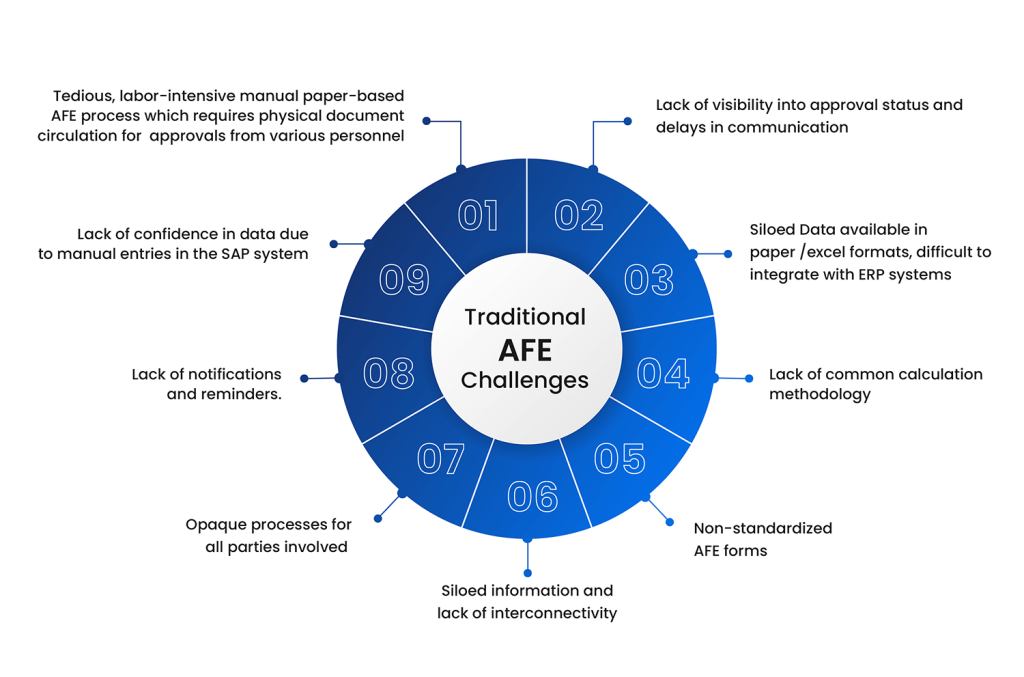The Authorization for Expenditure (AFE) business process plays a vital role in the energy sector, particularly the oil and gas (O&G) industry. It enables O&G companies to raise and obtain approvals on project funding proposals and get funds allocated from the Board’s approved budgeted expenditure. Owing to the critical nature of oil and gas projects and the exorbitant investment needs, AFE requires several levels of input and approval from various stakeholders, including surveyors, engineers, geologists, the finance and accounting team, lawyers, and of course, the leadership.
Where does the challenge lie? A single AFE constitutes billions of dollars worth of investment for oil and gas players, an industry where returns are on the brink of making operations unviable. Therefore, there isn’t room for much error or inaccuracy when it comes to investment decisions. Moreover, manual paper-based AFE preparation and approval can take several months, often comprising thousands of line items in a single document.
Depending upon on-field maturity and development, traditional AFE processes may be inefficient at cost curtailment. The acceptable industry range for AFE estimates is +/- 20%, which is A) far too wide, and B) leading to missed earning opportunities across the industry. For example, an estimated $10 million cost of a new well, when extrapolated across 120 AFEs (across the entire well drilling program), will lead to a $480 million acceptable range, assuming a +/- 20% acceptable variance.
So, where is the industry lacking?
Challenges with the current Authorization for Expenditure (AFE) process
A mere lack of common methodology for AFE calculations has been plaguing the industry for the longest time. For starters, AFE calculations may vary significantly between two different engineers. While one calculation model may be accurate, another may miss the mark significantly, leading to a 40% potential difference between different methods. On top of that, mapping line items to GL code categories across several AFEs is another challenge.
Another obstacle to accurate AFE calculation is the AFE form design. Developing a robust, “overarching” AFE form that standardizes project cost prediction, budget analysis, and capital allocation across the entire organization is crucial to ensuring accurate budget allocations. An “all-encompassing” form design, tying GL codes with engineering inputs significantly reduces the time and effort required to come to a fair project estimate. Additionally, this enables easier and more effective single-project and multi project look-back analyses.
Thirdly, siloed information and lack of interconnectivity between business segments hinder precise AFE calculation. Each decision-maker has a set of inputs that must be collated to calculate the requisite expense. Linked AFE inputs and a shared data repository are necessary components for enhanced AFE accuracy, better project management, reduced development time, and improved transparency.
Take, for instance. A Business Unit manager realizes that a well is projected to go $2 million over budget. Unfortunately, the engineer responsible for the AFE quit the company a few months ago, leaving the entire team with neither the ability to examine the cause of overestimation in the original AFE nor the potential to improve upon it for future projects.
The Problem: Traditional Authorization for Expenditure Process

The Solution: Authorization for Expenditure (AFE) Modernization
Authorization for Expenditure Modernization or AFE Automation streamlines the end-to-end AFE process — initial request for approval, budget creation, tracking approval status, reporting, and project close-out.
Consequently, it results in complete cost transparency, accurate spending to date against budget, and data availability on the remaining budget across various heads.
By supporting unlimited AFE types and delivering full spending against budget, the solution accounts for every tangible or intangible cost. Moreover, it records every single expenditure against the corporate budget, helping create user-defined reports and identify overspends.
Let’s take this up with the help of a quick example. Our client, an independent oil and gas exploration (E&P) company with a regional focus on the North Sea, North Africa, and Southeast Asia, was processing 400 to 500 AFEs manually, each taking about 2-3 weeks.
Consequently, it suffered the pain points that have been listed above.
Our Solution
Using Azure and the Power Platform, we deployed a quick solution that boasted the following features:
- Low Code No Code Power Apps based AFE Modernization
- Automated task creation, tracking, and reminders for all the departments involved
- Full traceability into the complete process flow.
- Seamless integration with ERP
- Digital forms to submit AFE and dashboard view with filters.
- Level of approval is decided by configuring workflows based on amount
- Usage of the application also brings transparency to the approval process as to whom and when the AFE is currently assigned. With easy follow up
- Users can easily trace historical AFEs they have been part of, which was difficult earlier.
- Mail notification when an AFE is assigned for quick action.
- Delegation process when approver/reviewer is on-leave or not available
- Multi-lingual Support
Business Benefits Achieved:
- 50% Time Savings (no more physical document circulation across departments)
- 80% faster response times for AFE approvals.
- Immediate visibility to delays/bottlenecks in approvals.
- 7X Paper Savings
- 100% transparency in the AFE approval process.
- Auditing visibility for accountability.
Technology-driven Outcomes:
- 100% accuracy in details fed into SAP.
- 100% traceability in the complete process.
- Save time & improve efficiency.
- Mobile-ready with offline capability.
How can Acuvate help?
We have helped some large Oil & Gas organizations build and deploy safe and smart new-age digital solutions that fuels the new-possible across the oil & gas value chain . We have proven expertise in the energy domain, having worked with reputed names such as Shell, Neptune Energy, Seadrill, with successful rollouts of Digital workplace solutions, Backoffice processes automation & production optimization solutions, Data & Advanced analytics, Workplace safety solutions, Workforce analytics, Virtual Assitants.
For more insights into the role of AI in driving innovation in the oil and gas sector, check out our blog on Six Applications of AI in the Oil & Gas Industry.
Contact us to explore how our solutions can help your business. Our solutions can be deployed without any modifications to the existing legacy IT landscape to deliver Proof of Value and scale.



